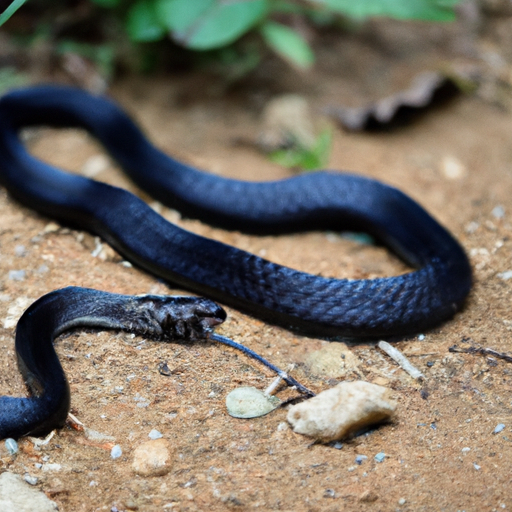So you’re planning a trip to Bali, eh? Well, before you pack your bags and head off to the gorgeous beaches and lush forests of this tropical paradise, there’s one question that might be nagging at the back of your mind – “Are there poisonous snakes in Bali?”
It’s a valid concern, after all, snakes can be quite dangerous. In this article, we will take a closer look at the snake population in Bali and shed light on whether or not you should be worried about encountering any venomous critters during your visit.

Common Snakes in Bali
Bali is known for its beautiful beaches, vibrant culture, and stunning landscapes. However, it is also home to a variety of snake species.
While most of these snakes are harmless and play a vital role in the ecosystem, there are a few venomous ones that you need to be aware of when visiting the island paradise.
Here are the common snakes you may encounter in Bali:
Paradise Tree Snake
The Paradise Tree Snake, also known as the Flying Snake, is a sight to behold. With its vibrant green color and slender body, it is often mistaken for a dangerous snake.
However, it is completely harmless to humans. This snake is highly adapted to climbing trees and can glide through the air, making it a fascinating creature to observe.
Banded Krait
The Banded Krait is one of the most venomous snakes in Bali. Its distinctive black and white bands make it easy to identify.
While this snake typically avoids human contact, encounters can occur, especially in rural areas. It is important to exercise caution and stay away from this venomous species.
Spitting Cobra
The Spitting Cobra is a snake that should be approached with extreme caution. As the name suggests, this snake has the ability to project its venom towards its victim’s eyes with great accuracy.
While not usually aggressive, if threatened or cornered, it may resort to spitting as a defense mechanism.
It is crucial to keep a safe distance and avoid any confrontation with this dangerous snake.
Green Tree Viper
The Green Tree Viper is a beautifully colored snake often found in the trees of Bali’s lush forests. Its bright green scales provide excellent camouflage among the foliage.
While it possesses venom, it is not considered highly dangerous to humans. However, it is advised to keep a safe distance and admire this snake from afar.
White-lipped Pit Viper
The White-lipped Pit Viper is another venomous snake species found in Bali. Its distinctive white lips and triangular head make it easily recognizable.
This snake is known for its aggressive behavior and should be avoided at all costs. If you spot a White-lipped Pit Viper, it is best to give it a wide berth and not provoke it.

Types of Poisonous Snakes
When it comes to venomous snakes in Bali, they can be categorized into three main types: Vipers, Cobras, and Kraits.
Understanding these categories can help you recognize and identify the venomous snakes you may encounter on the island.
Vipers
Vipers are a group of venomous snakes known for their long, hinged fangs used to inject venom into their prey.
In Bali, several viper species can be found, including:
White-lipped Pit Viper
As mentioned earlier, the White-lipped Pit Viper is a venomous snake that poses a threat to humans.
Its venom can cause severe pain, swelling, and tissue damage.
Mangrove Pit Viper
The Mangrove Pit Viper, as the name suggests, is often found in coastal areas and mangrove forests.
It has a range of colors, including yellow, green, and brown. While its venom can cause discomfort and pain, it is generally not lethal to humans.
Hundred-pace Viper
The Hundred-pace Viper, also known as the Bamboo Pit Viper, is a venomous snake that can be found in both lowland and highland forests. Its venom contains potent hemotoxins, which can lead to significant tissue damage and complications if bitten.
Russell’s Viper
While Russell’s Viper is not as commonly encountered in Bali as other viper species, it is still present on the island.
This snake is responsible for a significant number of snakebite cases in Southeast Asia and is known for its aggressive nature and potent venom.
Cobras
Cobras are iconic venomous snakes known for their ability to expand their necks into a hood when threatened.
In Bali, you may come across the following cobra species:
Spitting Cobra
The Spitting Cobra, mentioned earlier, is undoubtedly one of the most dangerous snakes in Bali.
Its ability to spit venom accurately can cause excruciating pain and potentially permanent damage to the eyes if not treated immediately.
Equatorial Spitting Cobra
The Equatorial Spitting Cobra, also known as the Black-necked Spitting Cobra, is another venomous snake species found in Bali.
Similar to the Spitting Cobra, it possesses the ability to project its venom towards its target. It is crucial to exercise caution and avoid any close encounters with this snake.
Monocled Cobra
The Monocled Cobra is a highly venomous snake that can be found in various habitats, including forests, grasslands, and even urban areas.
Its characteristic “eyeglasses” pattern on the back of its hood makes it easily recognizable. This cobra should be approached with extreme caution.
Kraits
Kraits are venomous snakes belonging to the same family as cobras. While they may not possess the same iconic hooded appearance as cobras, they are equally dangerous.
In Bali, the following krait species can be found:
Malayan Krait
The Malayan Krait, also known as the Blue Krait, is a highly venomous snake with striking black and white stripes.
It is primarily nocturnal and tends to avoid human contact. However, if encountered, it is important to exercise caution as its venom can cause paralysis and potentially be lethal.
Banded Krait
The Banded Krait, mentioned earlier, is a venomous snake that poses a significant threat to humans. Its distinctive black and white bands make it easily distinguishable from other snake species.
It is important to exercise caution and avoid any interactions with this dangerous snake.
Blue Krait
The Blue Krait, also known as the Malayan Krait, is a highly venomous snake that can be found in various habitats, including forests and agricultural areas.
Its aggressive nature and potent venom make it one of the most dangerous snakes in Bali.
Final Thoughts
In conclusion, Bali is indeed home to various snake species, including some venomous ones. While encountering snakes is relatively rare for tourists, it is essential to be aware of the potential risks and take necessary precautions. Understanding the common snakes in Bali, their types, snakebite incidents, first aid measures, and snake safety measures can help ensure a safe and enjoyable experience on the beautiful island of Bali. Remember, knowledge and preparedness are key when it comes to coexisting with these fascinating but potentially dangerous creatures.




